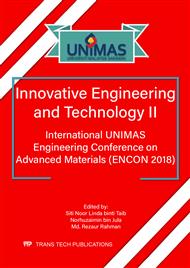[1]
N. Bray, M. Cohen, Dredging for development, International Association of Dredging Companies (IADC) & International Association of Ports and Harbors (IAPH), The Netherlands & Japan, (2010).
Google Scholar
[2]
R.N. Bray, A.D. Bates, J.M. Land, Dredging: a handbook for engineers, 2nd ed., Butterworth-Heinemann, (1997).
Google Scholar
[3]
K.J. Kim, D.H. Kim, J.C. Yoo, K. Baek, Electrokinetic extraction of heavy metals from dredged marine sediment, Separations and Purification Technology. 79 (2011) 164–169.
DOI: 10.1016/j.seppur.2011.02.010
Google Scholar
[4]
K.Y. Hwang, S.Y. Park, W.S. Baek, J.H. Jung, W.S. Shin, N.J. Lee, I.S. Hwang, Speciation and leaching potential of heavy metals in sediments of nakdong river, J. Korean Soc. Water Wastewater 21 (2007) 113-122.
Google Scholar
[5]
W. Zhu, C.L. Zhang, A.C.F. Chiu, Soil-water transfer mechanism for solidified dredged materials, Journal of Geotechnical and Geoenvironmental Engineering 133(5) (2007) 588-598.
DOI: 10.1061/(asce)1090-0241(2007)133:5(588)
Google Scholar
[6]
G. Kang, T. Tsuchida, A.M.R.G. Athapaththu, Engineering behaviour of cement-treated marine dredged clay during early and later stages of curing, Engineering Geology 209 (2016) 163-174.
DOI: 10.1016/j.enggeo.2016.05.008
Google Scholar
[7]
A. Prakash, A. Paul, A study on stabilization of marine dredged soil using quarry dust, International Journal of Scientific Engineering and Research (IJSER) 4(3) (2014) 83-86.
Google Scholar
[8]
B. Rekik, M. Boutouoil, Geotechnical properties of dredged marine sediments treated at high water/cement ratio, Geo.Mar. 29 (2009) 171-179.
DOI: 10.1007/s00367-009-0134-x
Google Scholar
[9]
N.S. Nordin, C.M. Chan, Evolution of shear strength with varying cement dosages in dredged marine soils, MCRJ Special Issue 5(3) (2018) 65-72.
Google Scholar
[10]
C.F. Chiu, W. Zhu, C.L. Zhang, Yielding and shear behaviour of cement-treated dredged materials, Engineering Geology 103 (2008) 1-12.
DOI: 10.1016/j.enggeo.2008.07.007
Google Scholar
[11]
R.J. Zhang, A.M. Santoso, T.S. Tan, K.K. Phoon, Strength of high water-content marine clay stabilized by low amount of cement, Journal of Geotechnical and Geoenvironmental Engineering 139(12) (2013) 2170-2181.
DOI: 10.1061/(asce)gt.1943-5606.0000951
Google Scholar
[12]
N.S. Nordin, C.M. Chan, Undrained shear strength of low dosage cement-solidified dredged marine soils (DMS) for reclamation works, International Journal of GEOMATE 13(35) (2017) 180-186.
DOI: 10.21660/2017.35.97494
Google Scholar
[13]
N. Mosavat, E. Oh, G. Chai, A review of electrokinetic treatment technique for improving the engineering characteristics of low permeable problematic soils, International Journal of GEOMATE 2(2) (2012) 266–272.
DOI: 10.21660/2012.4.3i
Google Scholar
[14]
V. Gingine, R. Shah, P.V.K. Rao, P.H. Krishna, A review on study of electrokinetic stabilization of expansive soil, National Conference on New Trends in Civil Engineering and Earth Sciences (2013) 391–399.
Google Scholar
[15]
H. A. Keykha, B.B.K. Huat, A. Asadi, S. Kawasaki, Electro-biogrouting and its challenges, International Journal of Electrochemical Science 7 (2012) 1196–1204.
Google Scholar
[16]
S.A. Ahmad Tajudin, N.S. Nordin, A. Marto, A. Madun, M.H. Zainal Abidin, I. Jefferson, M.A. Mohammad Azmi, The monitoring and cementation behavior of electrokinetic stabilisation technique on Batu Pahat marine clay, International Journal of GEOMATE 11(26) (2016) 2581-2588.
DOI: 10.21660/2016.26.5396
Google Scholar
[17]
S. Jayasekera, Electrokinetics to modify strength characteristics of soft clayey soils: a laboratory based investigation, Electrochimica Acta 181 (2015) 39-47.
DOI: 10.1016/j.electacta.2015.06.064
Google Scholar
[18]
S. Jayasekera, J. Mewett, S. Hall, Effect of electrokinetic treatment on the properties of a salt affected soil, Australian Geomechanics Journal (2004).
Google Scholar
[19]
K.Y. Lo, S.D. Hinchberger, Stability analysis accounting for macroscopic and microscopic structures in clays, Fourth International Conference on Soft Soil Engineering (2006) 3-34.
Google Scholar
[20]
N.S. Nordin, Physicochemical properties of batu pahat clay using electrokinetic stabilisation method, Master Thesis, Universiti Tun Hussein Onn Malaysia, (2015).
DOI: 10.5171/2015.725644
Google Scholar
[21]
P. Asavadorndeja, U. Glawe, Electrokinetic strengthening of soft clay using the anode depolarization method, Bull. Eng. Geol. Environ. 64 (2005) 237-245.
DOI: 10.1007/s10064-005-0276-7
Google Scholar
[22]
H. Moayedi, S. Kazemian, B.B.K. Huat, K. Mazloomi, H. Niroumand, N.N. Nik Daud, Effect of calcium chloride on the electrokinetic characteristics of organic soil, International Journal of Electrochemical Science 7 (2012) 7740–7749.
Google Scholar
[23]
C.Y. Ou, S.C. Chien, R.H. Liu, A study of the effects of electrode sapcing on the cementation region for electro-osmotic chemical treatment, Applied Clay Science 104 (2015) 168–181.
DOI: 10.1016/j.clay.2014.11.027
Google Scholar
[24]
C.Y. Ou, S.C. Chien, C.C. Yang, C.T. Chen, Mechanism of soil cementation by electroosmotic chemical treatment, Applied Clay Science 104 (2015) 135–142.
DOI: 10.1016/j.clay.2014.11.020
Google Scholar
[25]
T.T. Thanh Thuy, D.P. Eka Putra, W. Budianta, H. Hazarika, Improvement of expansive soil by electro-kinetic method, J. SE Asian Appl. Geol. 5(1) (2013) 50-59.
DOI: 10.22146/jag.7207
Google Scholar
[26]
P. Asavadorneja, U. Glawe, Electrokinetic strengthening of soft clay using the anode depolarization method, Bulletin of Engineering Geology and the Environment 64 (2005) 237–245.
DOI: 10.1007/s10064-005-0276-7
Google Scholar
[27]
G.A. Lorenzo, D.T. Bergado, Fundamental characteristic of cement-admixed clay in deep mixing, Journal of Material in Civil Engineering 18 (2006) 161–174.
DOI: 10.1061/(asce)0899-1561(2006)18:2(161)
Google Scholar
[28]
A. Porbaha, S. Shibuya, T. Kishida, State of the art in deep mixing technology. Part III: geomaterial characterization, Ground Improvement 3 (2000) 91–110.
DOI: 10.1680/grim.2000.4.3.91
Google Scholar
[29]
L.D. Nguyen, B. Fatahi, H. Khabbaz, A constitutive model for cemented clays capturing cementation degradation, International Journal of Plasticity 56 (2014) 1–18.
DOI: 10.1016/j.ijplas.2014.01.007
Google Scholar
[30]
H. Moayedi, M. Mosallanezhad, R. Nazir, S. Kazemian, B.K. Huat, Peaty soil improvement by using cationic reagent grout and electrokinetic method, Geotech. Geol. Eng. (2014).
DOI: 10.1007/s10706-014-9770-7
Google Scholar
[31]
K. Ahmad, M.R. Taha, K.A. Kassim, Electrokinetic treatment on a tropical residual soil, Ground Improvement 164 (2011) 3-13.
DOI: 10.1680/grim.800025
Google Scholar


